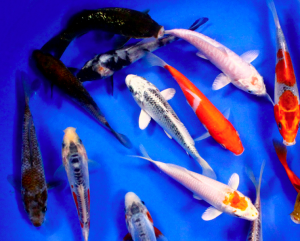Koi Fish Facts
Making the Grade: How Quality Koi are Selected
As you look at your pond and the vibrant colors of your Living Jewels while they flash by, you might have wondered as to how those beautiful brocaded carp were selected in the first place.
The Grades
As you might suspect, the grade convention was devised in Japan. Here, the young koi are inspected, and given a letter A to denote the quality. A single A meant lower to mid-quality, double-A (AA) was mid- to high-quality and triple-A (AAA) was the highest quality.
In the U.S., a different naming convention for the grading system developed. Next Day Koi’s supplier, Blue Ridge Fish Hatchery— the largest and oldest koi farm in the US—was the first hatchery to devise a separate grading system. They settled on standard grade, premium grade and premium select grade to differentiate quality.
This naming system has earned many admirers in U.S. koi circles, and many farms have adopted similar naming conventions for different grades.
So How Are Koi Graded?

How is it that koi suppliers can sort through quite literally thousands of koi and see quality that would probably be missed by mere koi hobbyist mortals? In Japanese, selection is known simply as Senbetsu. Only, it’s not simple. In fact, it’s considered an art form.
After picking thousands of fish in a day, I sometimes go home and close my eyes, only to see thousands more fish in my mind’s eye.
Given that many young koi will undergo some fairly substantial changes in the course of their life, it is easy to see how this is considered more of an art than a science. Some enthusiasts might even argue grading koi is a magic, peering into the future to see the koi at its final stage of development. Think Koistradamus.
When picking fish, the highly experienced selector leans on years and years of experience, and knows exactly what to look for when viewing young fish. It’s the experience of looking at developing koi that gives the selector a unique insight into the changes that a koi will more than likely undergo as it matures.

It isn’t a practice for the faint of heart. Or the impatient, either. There are a lot of nuances to consider. For example, koi will mature differently from variety to variety, and even within different bloodlines of the exact same variety! A koi that seems to be high quality at a young age might not mature into a high quality koi.
Selecting young koi to grow out is a perpetual learning process—you’re never finished, and there is always more knowledge to be gained.
It is complicated. And this is the value of the trial and error that experienced selectors have undergone. They will know, for example, young Sanke that look this certain way have a very strong chance of maturing to look this certain way. Often what looks to the untrained eye like a low quality fish at a young age can have the potential to mature into a high quality fish as it ages.

Breeders and koi farmers will know full well the qualities that make some koi versus others stand out in the crowd, even if they might not be able to articulate it exactly what they see. The ability to see the quality is a gift that is well respected and highly prized.
It’s a constant learning process, sometimes you’re right and other times you’re wrong. But each season and each fish adds to your overall feel for your bloodlines and increases your confidence in making the correct selection.
Of course, in any profession where aesthetic judgment is called for, there is always the element of personal taste or even bias. But Senbetsu isn’t arbitrary. Far from it. All koi, whether or not they go onto become grand champions or just a pleasant splash of color for a pond, are all judged on the same set of standards: color, body conformation and pattern. They are the criteria that forms the framework for any koi categorization. Trying to reinvent those strict boundaries won’t keep the selector in business for very long.
Next Day Koi is fortunate enough to work with some of the best local and international koi suppliers. All of our koi for sale go through a rigorous selection and quarantine process to ensure the highest quality in any grade of koi.
We will periodically get AAA-rated koi for sale, ranging in size and variety at some of the most competitive prices on the market. Join our email list or social media pages for notification of upcoming sales and offers.



